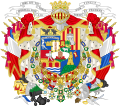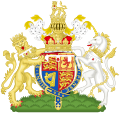User:VulpesVulpes42/sandbox
Modern heraldry[edit]
In the mid-19th century, there was a renewed interest in the history of armory, but now mostly from an antiquarian's or genealogist's perspective. This led to a re-evaluation of older designs over Baroque and Roccoco styles, a new appreciation for the medieval origins of the art.[1][2] Since the late nineteenth century, heraldry has focused on the use of varied lines of partition and little-used ordinaries to produce new and unique designs.[3]
-
19th-century German heraldry has examples of shields with numerous crests, as this arms of Saxe-Altenburg featuring a total of seven crests. Some thaler coins display as many as fifteen.
-
Example of complex achievements in 19th-century Spanish heraldry: Coat of arms of Baldomero Espartero, Prince of Vergara (1793–1879).
-
Coat of arms of the Kingdom of Prussia (1873)
-
Coat of arms of the Mexican Empire (1864)
-
Coat of arms of William, Duke of Cambridge (b. 1982, granted in June 2000, on his 18th birthday)
-
Modern coat of arms of the Swiss canton of Graubünden, combined (marshalled) from the three older (15th to 16th century) coats of arms of the Three Leagues in 1932.
-
The coat of arms of the Czech Republic of 1992 was designed based on heraldic principles by heraldist Jiří Louda. It shows the Bohemian lion quartered with the Silesian and Moravian eagles.
National heraldry[edit]
The term "heraldry" is sometimes used to include the national emblems of modern states. States with a republican tradition sometimes avoid coats of arms, instead using "national seals" or "national emblems" (such as the Emblem of Italy), using nonheraldic emblems in parallel to more heraldic arms (such as the diplomatic emblem of France), or by forgoing an official national emblem altogether (such as the case is with Turkey). National coats of arms are however popular among both constitutional monarchies (like Denmark and Spain) as well as republics (like Finland, Iceland, Portugal, the Gambia, Nigeria, Sierra Leone, Singapore, Chile, Guyana, Trinidad and Tobago, and the United States).
Case study: Malta[edit]
Malta attained its independence from the United Kingdom in 1964, with Queen Elizabeth II initially retained as the head of state. In the same year, new national arms were adopted. However, neither these, nor the monarchy would last particularly long, as the country declared itself a republic in 1974. Then Prime Minister Dom Mintoff sought to replace the national arms as he thought them unfit for the new republic. This opinion was based on a misconception that the included mural crown representing royalty.
-
The original arms of the newly independent Malta, used 1964–1975








